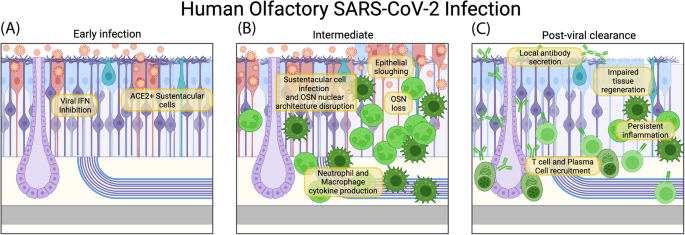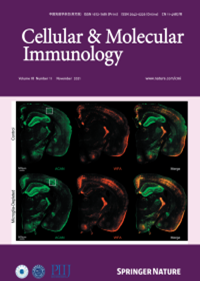Olfactory immune response to SARS-CoV-2
IF 21.8
1区 医学
Q1 IMMUNOLOGY
引用次数: 0
Abstract
Numerous pathogens can infect the olfactory tract, yet the pandemic caused by SARS-CoV-2 has strongly emphasized the importance of the olfactory mucosa as an immune barrier. Situated in the nasal passages, the olfactory mucosa is directly exposed to the environment to sense airborne odorants; however, this also means it can serve as a direct route of entry from the outside world into the brain. As a result, olfactotropic infections can have serious consequences, including dysfunction of the olfactory system, CNS invasion, dissemination to the lower respiratory tract, and transmission between individuals. Recent research has shown that a distinctive immune response is needed to protect this neuronal and mucosal tissue. A better understanding of innate, adaptive, and structural immune barriers in the olfactory mucosa is needed to develop effective therapeutics and vaccines against olfactotropic microbes such as SARS-CoV-2. Here, we summarize the ramifications of SARS-CoV-2 infection of the olfactory mucosa, review the subsequent immune response, and discuss important areas of future research for olfactory immunity to infectious disease.


对 SARS-CoV-2 的嗅觉免疫反应
许多病原体都可能感染嗅道,然而,SARS-CoV-2 引起的大流行却有力地强调了嗅觉粘膜作为免疫屏障的重要性。嗅觉粘膜位于鼻腔内,直接暴露于环境中,可以感知空气中的气味,但这也意味着它可以作为从外界进入大脑的直接通道。因此,嗅觉感染会造成严重后果,包括嗅觉系统功能障碍、中枢神经系统入侵、向下呼吸道扩散以及在人与人之间传播。最近的研究表明,需要一种独特的免疫反应来保护这种神经元和粘膜组织。我们需要更好地了解嗅觉粘膜的先天性、适应性和结构性免疫屏障,才能开发出有效的治疗方法和疫苗来对付 SARS-CoV-2 等嗅觉微生物。在此,我们总结了 SARS-CoV-2 感染嗅觉粘膜的影响,回顾了随后的免疫反应,并讨论了未来研究传染病嗅觉免疫的重要领域。
本文章由计算机程序翻译,如有差异,请以英文原文为准。
求助全文
约1分钟内获得全文
求助全文
来源期刊
CiteScore
31.20
自引率
1.20%
发文量
903
审稿时长
1 months
期刊介绍:
Cellular & Molecular Immunology, a monthly journal from the Chinese Society of Immunology and the University of Science and Technology of China, serves as a comprehensive platform covering both basic immunology research and clinical applications. The journal publishes a variety of article types, including Articles, Review Articles, Mini Reviews, and Short Communications, focusing on diverse aspects of cellular and molecular immunology.

 求助内容:
求助内容: 应助结果提醒方式:
应助结果提醒方式:


